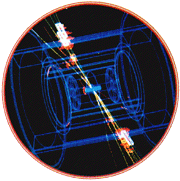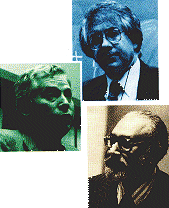There are two kinds of matter particles: quarks and leptons.

In this dossier |
Discover the odd characteristics of a menagerie or sub atomic
particles
Theorists think they understand how all the particles so far discovered are
related, using a mathematical description called the Standard Model of particles
and forces.
There are two kinds of matter particles: quarks and leptons.

Quarks
come in six "flavours" - up, down, strange, charm, bottom and
top - and are never seen alone. Two ups and one down make a proton, two downs
and one up make a neutron. All combinations are called hadrons, from the
Greek for heavy.
A quark has an electric charge of plus or minus one-third or plus or minus
two-thirds; so when two are combined they add up to plus one, minus one,
or zero. This explains why protons have an electric charge of one, and neutrons
have no electric charge at all.
Strange, charm and bottom quarks are heavier than up and down (quarks and
exist fleetingly in the high-energy realms found in accelerators and cosmic
ray events. They too are thought to have existed in the very first moments
of the universe.
The top quark has yet to be found. It is by the far the heaviest and making
it would require a very great amount of energy.
|
Leptons
(from the Greek for light) include the electron, and the less familiar muon
and tau (both of which are heavier, unstable versions of the electron). All
leptons have an electric charge of plus or minus one.
For each of these three there is a neutrino partner. Neutrinos are bizarre
entities: in fact they're hardly there at all, having no electric charge
and little or no mass. But their role in the universe is extremely important
(see the article on neutrinos in the May 1993 edition of Focus).
The Standard Model
All 12 leptons and quarks are split up into three "generations", each comprising
a pair of quarks and a pair of leptons. In increasing order of mass, these
are: the up and down quarks, and the electron and electron neutrino; the
strange and charm quarks, and the muon and muon neutrino; the top and bottom
quarks, and the tau and tau neutrino (the tau neutrino is yet to be found).
Scientists have identified four basic "forces of nature" that explain why
these building blocks of matter stick together.
Electromagnetic force
This is the cement that holds atoms and molecules together and
is responsible for their chemical behaviour. It is "felt" by all charged
particles and can be either positive or negative; like charges repel, unlike
charges attract.
In the tried and trusted theory of how electromagnetic force works - known
as quantum electrodynamics - a "field" is created by charged particles exchanging
"virtual photons ".
The strong force
A similar field theory explains what holds the central nucleus
together. The strong nuclear force is felt only by quarks and has a very
short range.
This force acts like a piece of stretched elastic, getting stronger with
distance, which explains why quarks are never alone. The strong force comes
in three "colours" - red, green and blue. (These are not real colours, just
another physicists' tease.)
Colour is the "strong" analogue of electric charge and is carried by a particle
called a gluon. Different colour gluons are attracted to each other and are
thought to cluster together to form "glueballs", although no one has ever
seen these.
 |
Heroes of the particle revolution Sheldon Glashow (top),Steven Weinberg (middle) and Abdus Salam (left): their theory points to a unified theory |
The weak force
This much weaker nuclear force allows quarks to change their
"flavour". (So up quarks can become down quarks, for example.) This explains
a kind of radioactivity in which a neutron becomes a proton, emitting an
electron and a neutrino. The weak force is carried by three different particles:
the W+, W- and neutral Zo. These particles
differ from other force particle in that they have mass.
Gravity
Theorists think even gravity may be mediated by particles, dubbed
gravitons. But in practice gravity is explained by general relativity and
not by the weird quantum theory used in particle physics.
![]() Mar94 p54
Mar94 p54